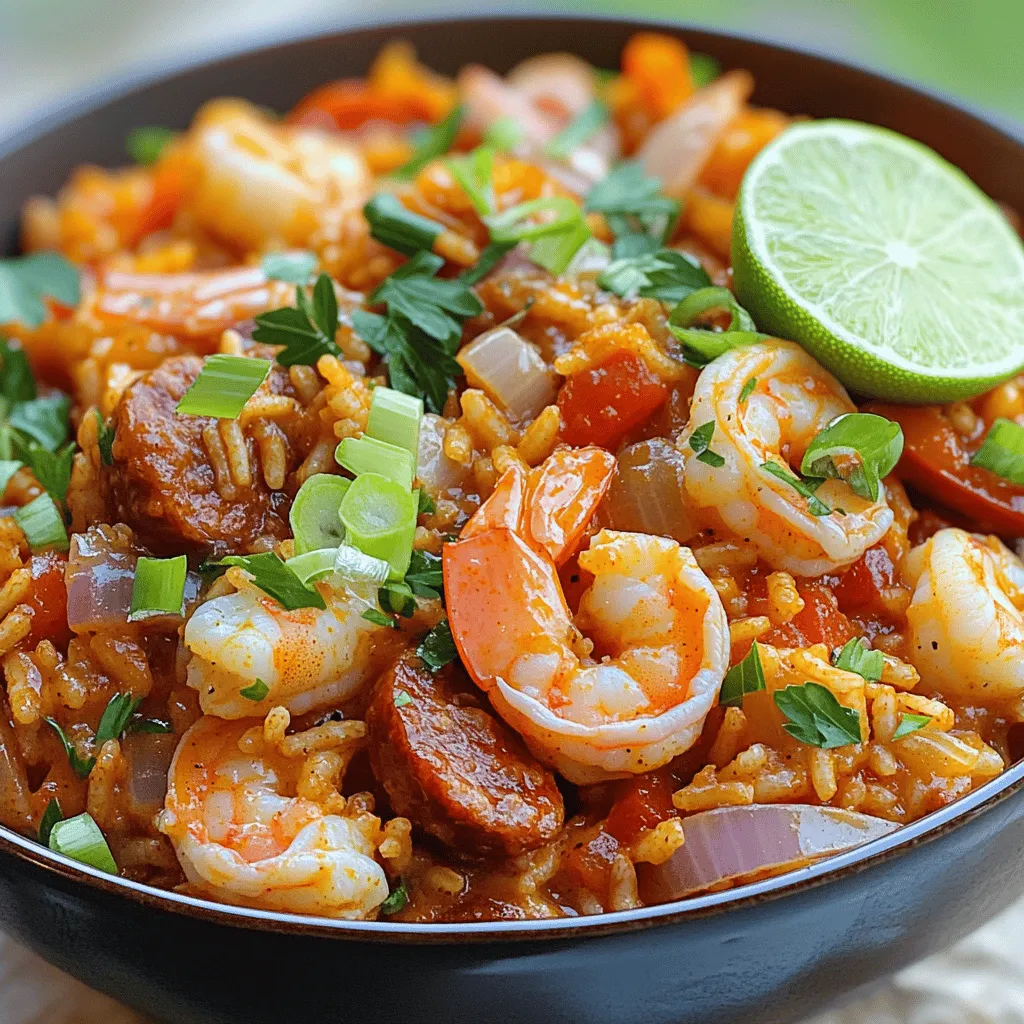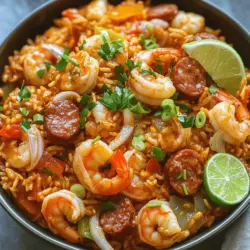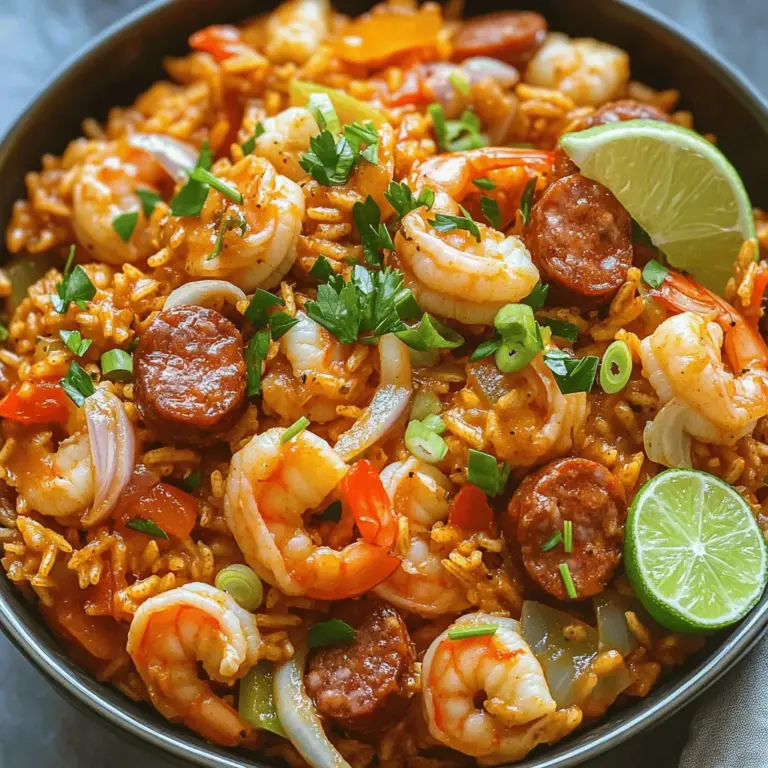Looking for a meal that bursts with flavor and is easy to make? Jambalaya might be just what you need! In this post, I’ll share a simple jambalaya recipe packed with shrimp, chicken, sausage, and fresh veggies. You’ll learn step-by-step how to create this delicious dish right in your kitchen. Plus, I’ll share tips for variations, storage, and reheating. Get ready for a meal that will impress your friends and family!
Ingredients
Essential Ingredients for Delicious Jambalaya
To make a great jambalaya, you need key ingredients. Start with proteins like shrimp, chicken, and sausage.
- 1 lb shrimp, peeled and deveined
- 1 lb chicken thighs, boneless and diced
- 1 cup andouille sausage, sliced
These proteins bring rich flavors. The shrimp adds a sweet touch, while chicken provides heartiness. The sausage gives it that smoky kick.
Next, you need vegetables. Onions and bell peppers are essential.
- 1 large onion, diced
- 1 green bell pepper, diced
- 1 red bell pepper, diced
- 3 cloves garlic, minced
These veggies add depth and color. Onions bring sweetness, while bell peppers offer a nice crunch. Garlic adds a wonderful aroma.
Seasoning is key for flavor. You will need:
- 4 cups chicken broth
- 2 tablespoons Cajun seasoning
- 1 teaspoon dried thyme
- 2 bay leaves
- Salt and black pepper to taste
The chicken broth gives a savory base. Cajun seasoning adds a spicy twist. Thyme and bay leaves enhance the aroma and flavor.
Don’t forget the rice! You will need:
- 2 cups long-grain rice
This rice soaks up the broth and flavors.
Finally, for a nice touch, use garnishes:
- 1 cup green onions, sliced (for garnish)
- Fresh parsley, chopped (for garnish)
Garnishes add color and freshness. They make your dish look and taste better.Enjoy your flavorful jambalaya!
Step-by-Step Instructions
Cooking the Meats
Start with the chicken thighs. Cut them into small pieces. Heat 2 tablespoons of olive oil in a large pot. Add the chicken and sprinkle salt and pepper over it. Cook for about 5 to 7 minutes, or until it turns brown. Stir it often to cook evenly. When the chicken is done, take it out and set it aside.
Next, cook the andouille sausage. In the same pot, add the sliced sausage. Cook it for another 3 to 4 minutes until it also turns brown. This adds great flavor to the pot. Remove the sausage and keep it with the chicken.
Make sure to avoid cross-contamination. Use clean utensils for the chicken and sausage. This keeps your meal safe and tasty.
Preparing the Vegetables
Now it’s time for the veggies. Add 2 more tablespoons of olive oil to the pot. Toss in the diced onion and both bell peppers. Sauté these for about 5 minutes. You want them to be soft and smell great.
After the vegetables soften, add the minced garlic and mix it in. Don’t add the garlic too early. It can burn and taste bitter. Stir in the Cajun seasoning, dried thyme, and bay leaves. Cook for just one more minute to wake up those flavors.
Combining Ingredients
Now, let’s bring everything together. Pour in the undrained diced tomatoes and chicken broth. Stir well and bring it to a boil.
Next, add the rice. Mix it in well, then lower the heat. Place the cooked chicken and sausage back into the pot. Cover it and let it simmer for about 20 to 25 minutes. The rice needs to soak up most of the liquid.
In the last 5 minutes, gently add the shrimp to the pot. Cover it again until the shrimp turn pink and are fully cooked. Before serving, take out the bay leaves and check the seasoning. Adjust with more salt and pepper if needed.Enjoy your flavorful jambalaya!
Tips & Tricks
Perfecting Texture and Flavor
To cook the rice just right, I recommend using long-grain rice. This type of rice stays fluffy and separate, which is key for jambalaya. When you add the rice to the pot, make sure to stir it in well. This helps it soak up all the tasty broth. Cook it on low heat so it doesn’t burn.
Adjusting the seasoning is also vital. After cooking, taste your jambalaya. If it needs more flavor, add a pinch of salt or more Cajun seasoning. A little extra spice can make a big difference.
Presentation Suggestions
Serving jambalaya can be a fun chance to show off your skills. Use large bowls to hold the dish. This allows the vibrant colors to shine. When plating, scoop a generous portion in the center.
Garnishing adds that gourmet touch. I love to sprinkle sliced green onions and fresh parsley on top. This not only looks beautiful but also adds fresh flavor. For an extra zing, you can add a lime wedge on the side. The bright color and taste will impress your guests!

Variations
Seafood Jambalaya
To make seafood jambalaya, you can use shrimp, crab, or scallops. Each adds a unique taste. I love using a mix for a rich flavor. When adding seafood, remember that cooking times differ. Shrimp cooks fast, so add it in the last 5 to 7 minutes. Crab and scallops may need a few minutes longer. This way, your seafood stays tender and juicy.
Vegetarian Jambalaya
For a meatless jambalaya, swap out the chicken and sausage. You can use more veggies like zucchini, mushrooms, or even eggplant. To keep it hearty, add some beans or lentils. For flavor, consider using smoked paprika or a dash of liquid smoke. These can mimic that warm, smoky taste from meat.
Spicy Jambalaya
If you like heat, start by adding more Cajun seasoning. You can also include diced jalapeños or hot sauce to the mix. When using fresh peppers, be careful. Adjust the amount based on your spice preference. If you want a milder dish, remove the seeds from the peppers. This keeps the flavor while lowering the heat.
Storage Info
Proper Storage Techniques
To keep your delicious jambalaya fresh, follow these tips:
- Refrigerating: Once the jambalaya cools, store it in an airtight container. It will stay good for up to 3 days in the fridge. Make sure to seal it well to avoid drying out.
- Freezing: If you want to save jambalaya for later, you can freeze it. Place portions in freezer-safe bags or containers. Remove as much air as possible to prevent freezer burn. Jambalaya can be frozen for up to 3 months.
Reheating Instructions
Reheating jambalaya properly helps maintain its great flavor. Here’s how to do it:
- Stovetop Method: Place the jambalaya in a pan over medium heat. Add a splash of chicken broth or water. Stir often until heated through, about 10-15 minutes.
- Microwave Method: Transfer a portion to a microwave-safe bowl. Cover it with a damp paper towel. Heat on medium power for 2-3 minutes, stirring halfway.
- Time and Temperature: Aim for 165°F (74°C) to ensure it’s safe to eat. This temperature keeps the flavors intact and makes it warm and tasty.
By following these storage and reheating tips, you’ll enjoy your jambalaya just as much the next day!
FAQs
What is the best rice for jambalaya?
The best rice for jambalaya is long-grain rice. It stays fluffy and separates well. I recommend using basmati or jasmine rice for extra flavor. These types absorb the spices nicely, making each bite delightful. Avoid short-grain rice; it tends to get sticky.
Can I make jambalaya in a slow cooker?
Yes, you can make jambalaya in a slow cooker. First, brown the meats in a pan. Then, place the cooked meats in the slow cooker. Add your vegetables, spices, tomatoes, broth, and rice. Cook on low for about 4-6 hours or until the rice is tender. This method makes the dish easy and hands-off.
How do I ensure my jambalaya is not dry?
To keep your jambalaya moist, use enough broth. The rice should absorb the liquid during cooking. Also, avoid overcooking the rice; check it around the 20-minute mark. Stir gently to avoid breaking the rice. If it seems too dry, add a splash of broth before serving.
What are the origins of jambalaya?
Jambalaya comes from Louisiana, blending Spanish and French influences. It likely started from paella, a Spanish dish. Over time, it evolved with local ingredients and flavors. You can find many variations, including Creole and Cajun styles, each with unique twists.
How long does jambalaya last in the fridge?
Jambalaya lasts about 3-4 days in the fridge when stored properly. Keep it in an airtight container. To ensure safety, reheat it thoroughly before eating. If you want to keep it longer, consider freezing it for up to three months. Just thaw and reheat when you’re ready to enjoy!
In this guide, I covered the key ingredients and steps to make jambalaya. We explored how to cook meats, sauté vegetables, and combine everything perfectly. I shared tips for enhancing texture and flavor, along with variations for seafood, vegetarian, and spicy options. Remember to store leftovers well and reheat them properly. Jambalaya is versatile and full of flavor. With these steps, you can create a delicious dish that fits your tastes. Enjoy making your jambalaya and share it with friends!


